Making a brazier with a metal cauldron with your own hands is a simple event, but it requires competent planning and taking into account some structurally important details. They relate to the choice of the type of structure, its location and materials. You should initially consider the issues of presentability of the structure, its durability, safety and ease of use.
Barbecue facilities with a cauldron
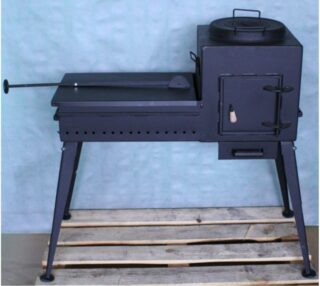
To assemble a brazier for a cauldron with your own hands, it takes a little time and skills in using household tools. A little effort in the long term will pay off with significantly expanded culinary opportunities.
The upgraded hearth can be used to prepare the following dishes:
- barbecue;
- baked vegetables and fruits;
- jacket potatoes;
- classic pilaf;
- kharcho;
- borscht;
- oriental delicacies;
- pies and pancakes.
It will also be possible to heat water, make tea, cook compotes and many other drinks, where prolonged heat exposure is required to achieve the desired effect.
Materials for making
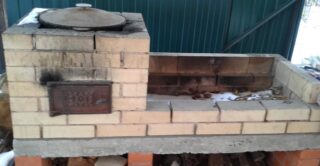
You can make a brazier under a cauldron with your own hands from the following materials:
- Cast iron. They are distinguished by their massiveness, high heat capacity, and corrosion resistance. Among the features, we can note the fragility, the complexity of processing and the possibility of cracks in contact with liquids in a heated state.
- Steel. In the manufacture of the usual metal is used for props and heat-resistant for the hearth. The best option is considered to be stainless steel, although it requires significant costs. Metal products are universal, they can be stationary, transportable and wearable, one-piece and collapsible.
- Brick. For the construction, the arrangement of the foundation, clay and fireclay bricks is required. The structures are stationary, installed once and for all, they can stand for several decades. The advantage of such devices is their stability, presentability and versatility.
The choice is determined by their own priorities, abilities and landscape of the site.
Types of construction
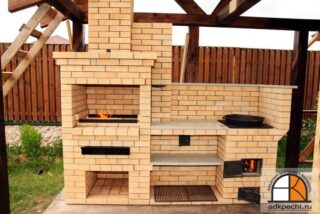
To make a brazier with a cauldron convenient and functional, you should initially think over its design.
By design, structures can be of this type:
- Covered. The modified hearth is installed on grass or a small area. A canopy is being erected above it, protecting the stove and the cook from precipitation and sunlight. Such a solution is practical, simple to implement, and requires minimal effort and expense.
- Universal. They represent a whole complex, where there is an open hearth, a stove for a cauldron, a chimney, shelves, tables, a sink, boxes for various accessories. The building is beautiful, pompous, but expensive. Provides for the supply of water, sewerage and electricity.
As a rule, light buildings are made in summer cottages, where the owners visit from time to time, and capital ones in the courtyards of private houses, where people live permanently.
How to calculate
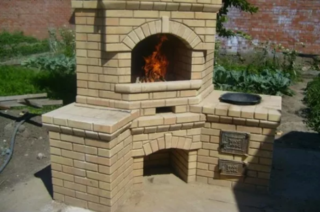
How convenient it will be to use it, the volume of product production, fuel consumption, and the level of safety directly depends on the correct choice of the size of the future furnace.
The following parameters should be correctly calculated:
- Length. An interval of 10 cm between skewers is considered optimal, plus 5 cm on each side to the walls.If there is a bowl, add its diameter at the installation site, provided the combined device. For 6 people, you need 70 cm for skewers and 30 cm for a container. Total 100 cm.
- Width. The standard length of the skewer is 30 cm. This means that for optimal heat distribution and no contact with the walls, 25 cm should be done. This is enough for a bowl of this diameter, since it is partially immersed in the brazier.
- Depth. It has been experimentally established that there should be a distance of 15-16 cm from the coals to the food.Taking into account the thickness of the coal layer 5-8 cm and the planted food 4-7 cm, a depth of 23-26 cm is made.
- Height. Selected for the growth of the culinary specialist. It is selected empirically when the distance from the ground to the elbow is measured. You can use a furniture standard of 80 cm.
When choosing the dimensions of the structure, one should not be tied to the size of the vat. It is much easier to find the right cookware than to customize the oven.
The version of the barbecue for a cauldron made of metal
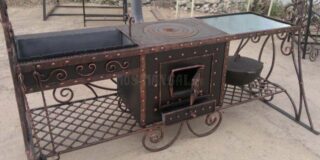
To more accurately determine the functionality of the hearth, you need to choose a place for its installation. If there are no restrictions, the structure is placed next to the recreation area - near the gazebo, bathhouse, next to the pond. It will not be superfluous to have a number of communications - water supply and sewerage.
The next step is project development. In the drawing, you need to display the following details:
- Base. It will be a monolithic reinforced concrete foundation with embedments or a site paved with tiles.
- Supports. Legs and shelves are indicated. As a rule, two shelves are made - one on top for dishes, the other on the bottom for firewood and coal.
- Brazier. Four walls and a base for the cauldron are drawn. The location of the bowl can be in the center or on the edge. The firebox can be shared or separate.
- Canopy or roof. This structure is needed to protect from snow, rain, sunlight. The roof can be shared with the hearth, removable, or be a separate structure covering the stove or the entire recreation area.
To cook a brazier with a place for a cauldron, you will need the following tools:
- welding;
- Bulgarian;
- drill;
- spanners;
- screwdrivers;
- roulette;
- square;
- level;
- a hammer.
List of materials:
- corner 30x30 mm;
- profile pipe 20x40 mm;
- refractory sheet steel 4-6 mm;
- cut by meter;
- bolts and nuts;
- rivets;
- electrodes, discs for metal;
- gas bottle or one rim.
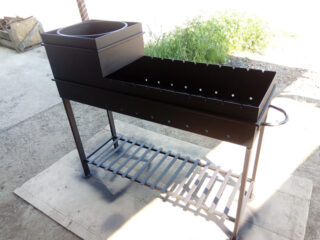
Standard brazier assembly instructions:
- Preparation of the workplace, checking the availability of materials and the operability of tools.
- Performing markup. Cutting metal into blanks. Cleaning of cuts from burrs, rounding of sharp edges, grinding of welding places.
- The connection of the walls to each other by spot welding. After shape correction, attachment to the bottom.
- Applying the final seams. Drilling holes in the bottom and bottom of the walls.
- Applying and fixing a stand for a cauldron. A ring from a gas cylinder or rim is used. Another option is a square of corners, in which it is possible to adjust the size for dishes of different sizes.
- Creation of support elements. A frame is made of pipes and corners, shelves are created, then the brazier and legs are joined together in a groove or for welding.
- Cutting holes in the walls for storing skewers. Depending on the priorities, they are given a triangular, square or semicircular shape. The latter is easier to clean from dirt.
In conclusion, the stove is cleaned of sags and splashes, decorative elements are applied to it if desired.
How to install a cauldron on the grill
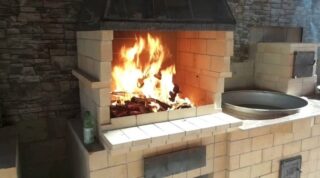
If you do not want to overload the brazier with additional options that increase its dimensions, you can use several effective ways to install a cauldron on a brazier.
The most popular options are:
- on bricks laid on the bottom of the hearth;
- on a grill grate of sufficient strength;
- on a hanging hook, with a stand-alone or combined support;
- on a special stand in the form of a rim with legs.
Each solution is attractive and practical in its own way.








